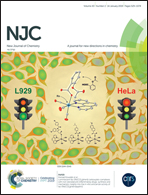Indolo[3,2-b]indole donor-based D–π–A dyes for DSCs: investigating the role of π-spacers towards recombination†
Abstract
Dye solar cells (DSCs) are gaining increasing interest since the recent realization of their high-performance potential in low/indoor light environments. Fused conjugated metal-free organic dyes have become a prominent class of dyes used in DSC in recent times by virtue of their better backbone rigidity, efficient charge transport properties, and the opportunity they provide for further structural modifications. Herein, we report the synthesis and characterization of three metal-free D–π–A organic dyes employing indolo[3,2-b]indole as the donor unit. The optical, electrochemical and photovoltaic properties have been analyzed in detail as a function of π-spacers, namely, benzene (IID-1), thiophene (IID-2) and furan (IID-3). Eventually, the best performance was demonstrated by the dye bearing benzene as the π-spacer. The role of recombination in determining the photovoltaic performance as a function of the nature of π-spacers was explored in detail, using various perturbation techniques on the fabricated devices, and compared with the results obtained from molecular orbital calculations.
![Graphical abstract: Indolo[3,2-b]indole donor-based D–π–A dyes for DSCs: investigating the role of π-spacers towards recombination](/en/Image/Get?imageInfo.ImageType=GA&imageInfo.ImageIdentifier.ManuscriptID=C8NJ04561E&imageInfo.ImageIdentifier.Year=2019)


 Please wait while we load your content...
Please wait while we load your content...